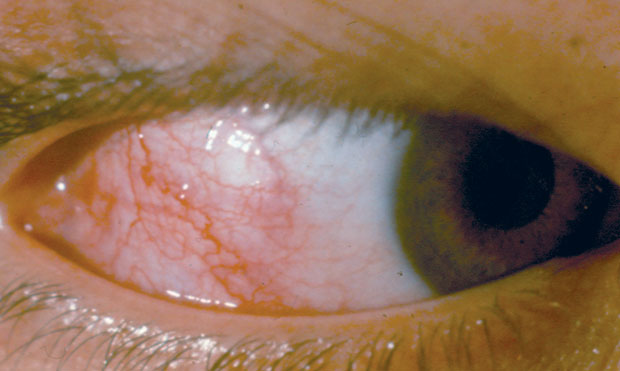MKSAP Quiz: Evaluation for redness, tearing, irritation of the eye
A 44-year-old woman is evaluated for redness, tearing, and irritation of the right eye that began 1 day ago. She reports no eye pain, photophobia, or change in vision. Her left eye is uninvolved. She has no other symptoms. Medical history is otherwise unremarkable, and she takes no medications.

On physical examination, visual acuity is 20/20 in both eyes. Pupils are equally round and reactive to light and accommodation. The right eye is shown.
There is no preauricular lymphadenopathy.
Which of the following is the most likely diagnosis?
A. Episcleritis
B. Herpes simplex keratitis
C. Scleritis
D. Uveitis
E. Viral conjunctivitis
Answer and critique
This content is available to MKSAP subscribers as Question 102 in the General Internal Medicine 2 section.
The most likely diagnosis is episcleritis (Option A), or inflammation of the episclera, the highly vascularized connective tissue layer that lies between the conjunctiva and sclera. This patient has a classic presentation of episcleritis, with abrupt onset of unilateral eye redness, irritation, and tearing. Pain, photophobia, and vision changes are typically absent. Examination shows dilation of superficial episcleral blood vessels, with normal sclera visualized between the blood vessels. Redness can be localized or diffuse; involvement is more commonly unilateral than bilateral. Nodular variants of episcleritis also occur. Although most causes of episcleritis are idiopathic, it can be associated with systemic conditions, including rheumatoid arthritis, vasculitis, and inflammatory bowel disease. Women are more commonly affected than men, with most cases occurring in those who are young or middle aged. Use of a topical vasoconstrictor, such as phenylephrine, results in improvement in eye redness and can help confirm the diagnosis.
Although herpes simplex keratitis (Option B) is in the differential diagnosis of red eye, it typically causes significant eye pain, photophobia, and visual blurring, which are not present in this patient. Herpes simplex keratitis can lead to vision loss due to corneal damage and, when suspected, should prompt immediate referral to an ophthalmologist.
Scleritis (Option C), inflammation of the sclera, is an unlikely diagnosis for this patient because it causes intense, boring eye pain and photophobia. The cardinal sign of scleritis is edema of the sclera often associated with a violaceous discoloration of the underlying sclera and intense dilation of the episcleral blood vessels accounting for the red eye.
Uveitis (Option D) is a potentially vision-threatening condition that typically causes severe ocular pain and photophobia, both of which are absent in this patient. In addition, the eye redness observed with uveitis is most prominent at the boundary between the iris and sclera, a pattern termed ciliary flush. In some patients, a collection of leukocytes (hypopyon) is seen pooling in the inferior aspect of the anterior chamber.
Viral conjunctivitis (Option E) is an unlikely diagnosis because it causes diffuse eye redness, as opposed to the localized redness seen in this patient. Symptoms of viral conjunctivitis classically start in one eye before spreading to the other eye. Eye redness is typically accompanied by watery discharge, and the tarsal conjunctiva may appear bumpy. Preauricular lymphadenopathy is commonly present.
Key Points
- The classic presentation of episcleritis is an abrupt onset of unilateral eye redness due to dilated episcleral blood vessels, irritation, and tearing, with no pain, photophobia, or change in vision.
- The cardinal sign of scleritis is edema of the sclera often associated with an underlying violaceous discoloration of the sclera and intense dilation of the episcleral blood vessels, accounting for the red eye.




